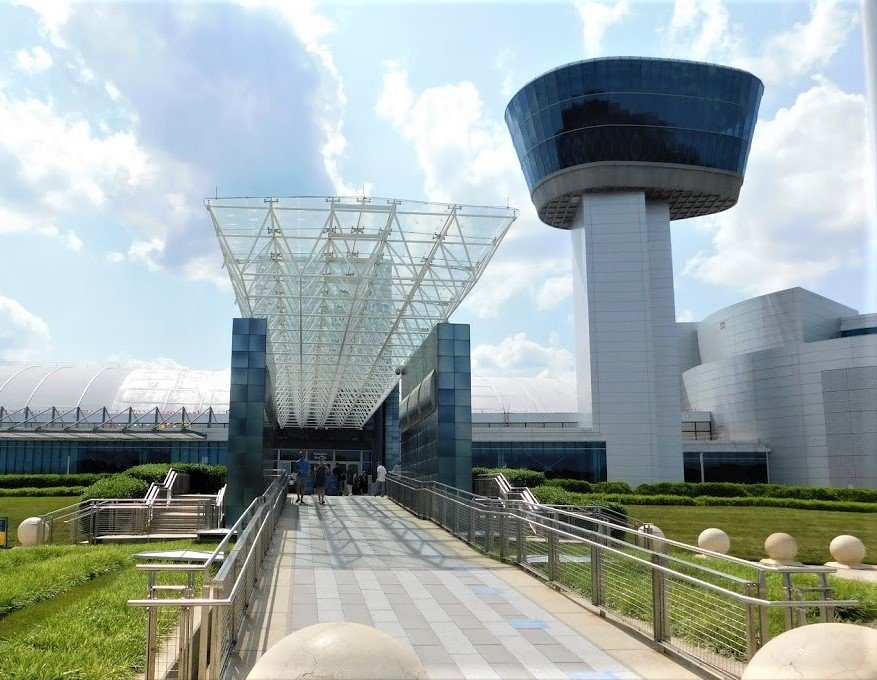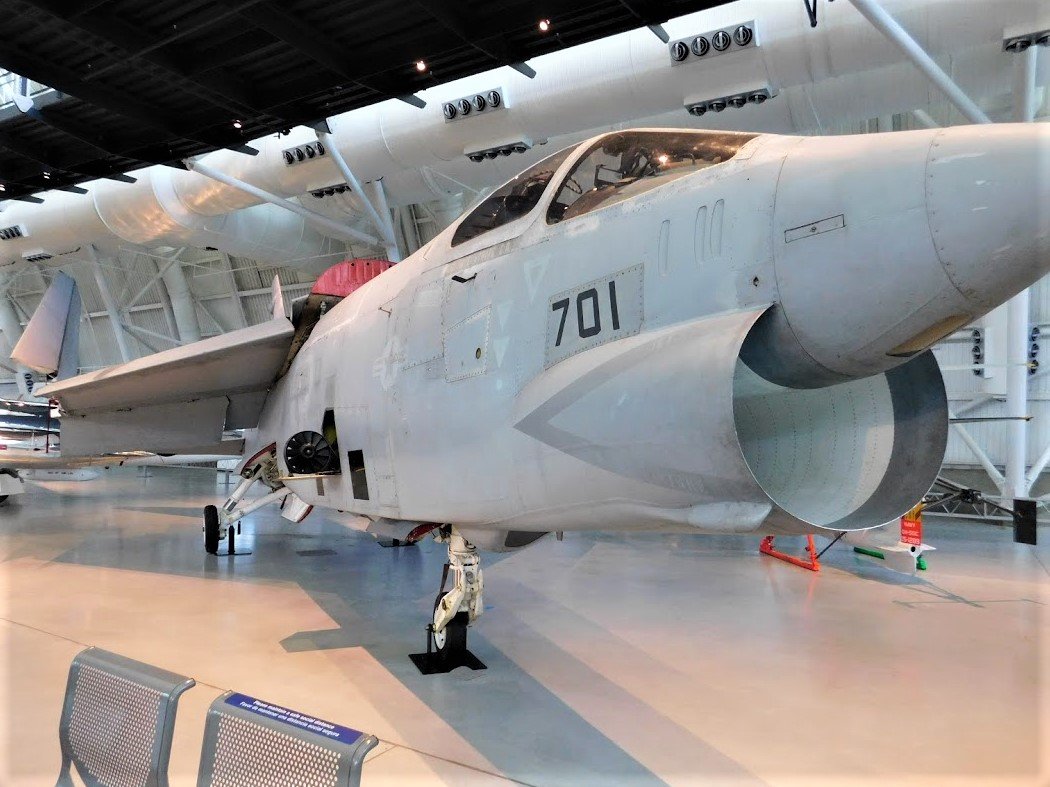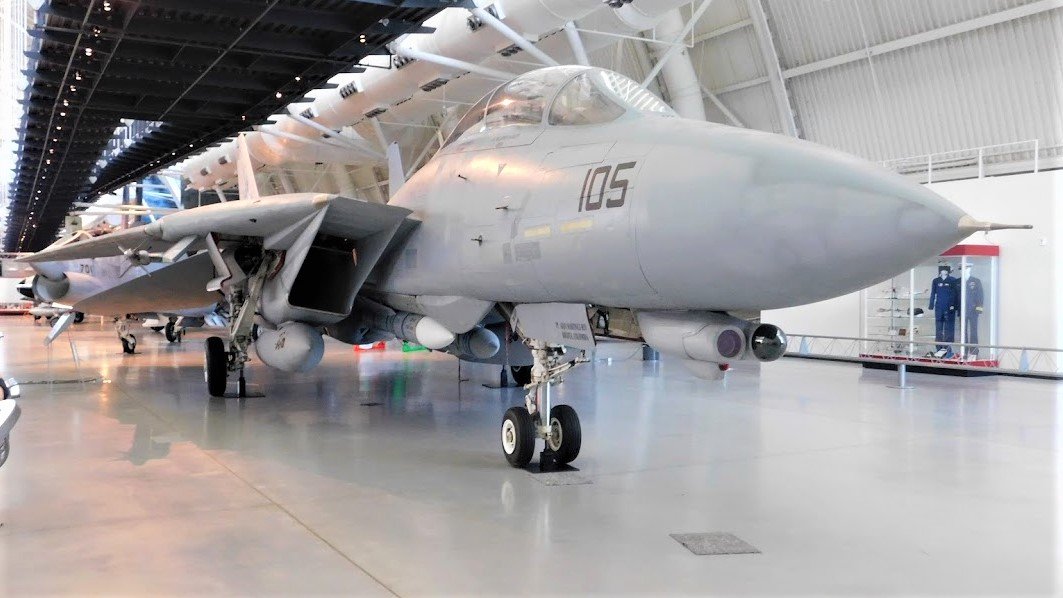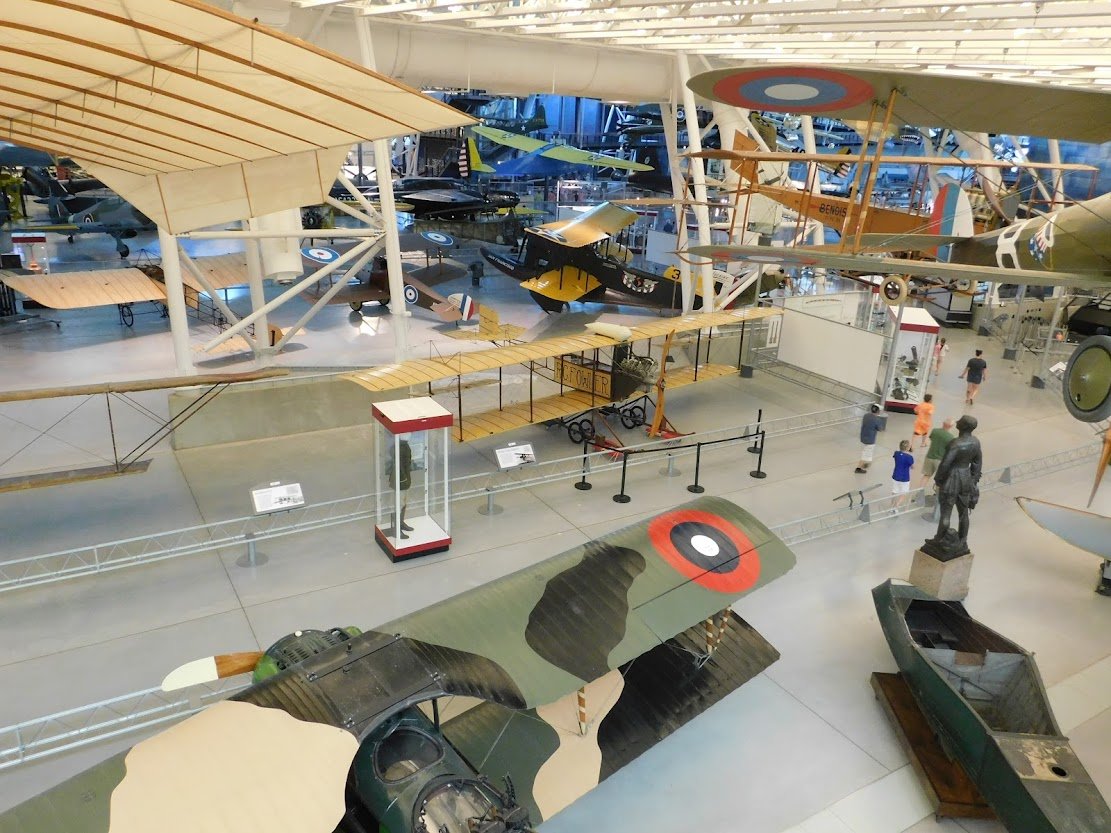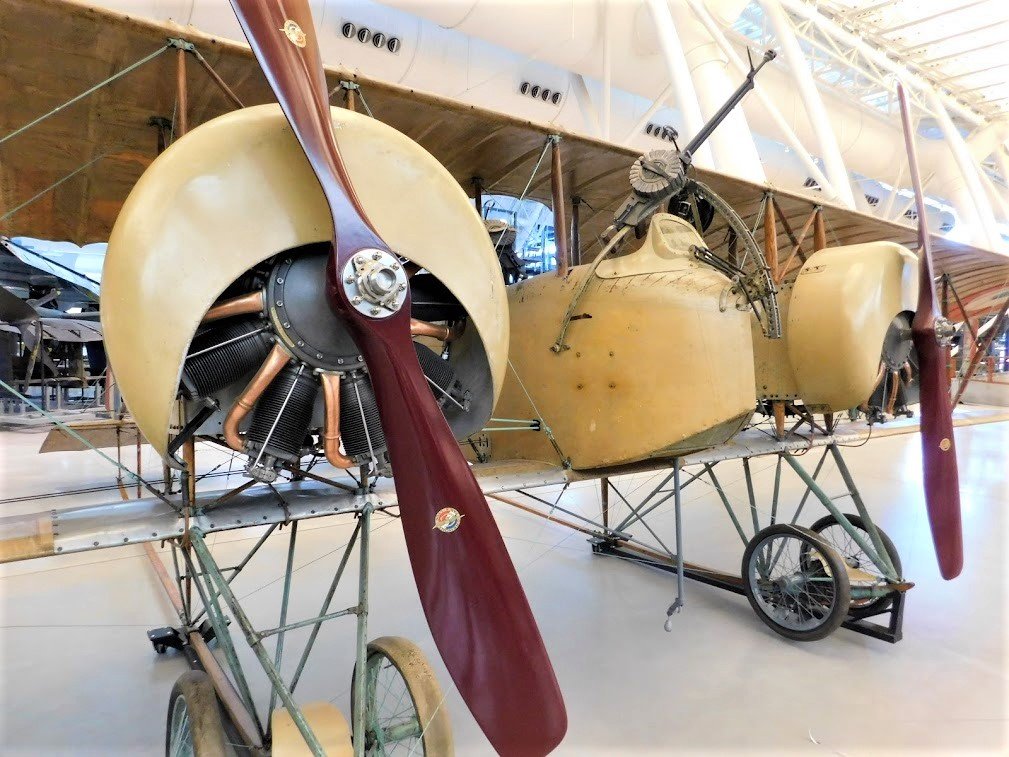The Smithsonian Udvar-Hazy Center, Chantilly VA (Part 1)
Issue 28 A visit to the Udvar-Hazy Center of the Smithsonian Chantilly VA (Part 1)
On December 8, 1903, Samuel Langley made a second attempt to launch his manned aircraft, the Aerodrome. The craft was launched by catapult from a houseboat moored on the Potomac River. Like his first attempt, this one was unsuccessful, and the plane again dropped straight down into the river. The ‘pilot’, Charles M. Manly, was unhurt, but the Aerodrome suffered structural damage and Langley made no more attempts to fly the craft. Nine days later, on December 17, the Wright Brothers made their historic first flight in Kitty Hawk, NC.
Langley’s Aerodrome, restored to original condition, hangs from the ceiling of the Udvar-Hazy Center, the Smithsonian National Air and Space Museum's annex at Washington Dulles International Airport.
------------------------------------------------
Regular readers know that I prefer to write about smaller, lesser known, museums, but a Gulfstream 650 trip with a full day off at Dulles offered an opportunity too good to pass up. This will be the first of two blogs about the Udvar-Hazy Center, and even then, I will only skim the surface of what is on display.
Opened in 2003, it is a massive museum (760,000 sq ft) with a large number of unique and historic aircraft and artifacts. The Smithsonian has always had many more items than they can put on display at the main Air and Space Museum in D.C. and for years most of the additional aircraft were stored at the Paul E. Garber Preservation, Restoration, and Storage Facility in Silver Hill, Maryland. A gift of $65 million from Steven F. Udvar-Hazy, a Hungarian immigrant who made his fortune in aircraft leasing, set in motion the construction of this new building.
The museum is described as being in two large hangars and it is organized loosely into sections, with many overlapping. It’s such a huge building that it invites you to just wander and not view the planes in any order. That’s what I did, and the airline section attracted my attention first.
This beautiful Boeing 307 Stratoliner drew me right in. The 307 first flew in 1938 and was the first pressurized airliner, ushering in the modern era of passenger aircraft. Only 10 of these beautiful planes were built before the advent of World War II. Other than the prototype, which crashed, TWA flew five of these planes and Pan Am flew three. The tenth became Howard Hughes’ personal plane (see issue 19 to read more about Hughes’ record setting flight in his Stratoliner).
The lines of this plane may look familiar- the wings, tail, and engines were the same as on the Boeing B-17C.
This particular 307 flew for Pan American as the Clipper Flying Cloud. It was restored in 2001 by Boeing employees.
I was really intrigued to get this shot of three generations of airliners: The Boeing 307 Stratoliner, The Boeing 707, the first really successful jet airliner (The De Havilland Comet was first), and the first, and only, successful supersonic airliner, the Concorde.
This Boeing is actually the prototype 707 and its original designation was the Boeing 367-80 or, “Dash-80”. Design work on the new jet began in 1952 and it first flew in 1954. Boeing did not have any orders for the plane but they were convinced there would be a market for it. Their first orders came from the Air Force, for the KC-135 tanker version, and this prototype had actually flown with a refueling boom for testing. Interestingly, the prototype had a 132 inch wide fuselage which would only support five-abreast seating. To sell to the airlines, Boeing increased the fuselage width to 148 inches, for six-abreast seating (the fuselage of the KC-135 is 144 inches wide).
The 707 incorporated a number of features, including rounded windows, thick aluminum skin, and plug-type doors that gave the fuselage strength to withstand high altitude pressurization. The Comet, which was operational by 1952, suffered a number of early accidents, several of which were later determined to be a result of structural failures from pressurization forces. The Comet was eventually redesigned and had some success, but by then the larger and faster 707 (as well as the Douglas DC-8) had taken over the market.
This prototype 707 continued flying in various marketing and experimental roles until 1969. At one point it was fitted with a fifth engine in the tail as a test bed for the 727. Perhaps the best-known event in the life of this plane occurred in 1955. While doing a fly-over at Seattle’s Seafair celebration, Boeing test pilot Tex Johnson performed two rolls in front of the crowd. When Boeing President Bill Allen asked Johnson why he did it, Tex replied that he was “just selling airplanes”.
The supersonic Concorde was built as a collaboration between the British company BAC (later BAE) and the French company Sud Aviation (later Aérospatiale). The international collaboration was a precursor to the formation of Airbus Industries.
Although many airlines originally ordered the Concorde, only British Airways and Air France eventually took delivery of the supersonic transports. First flown in 1969, the Concorde entered service in 1976. The only Concorde accident, in over 25 years of service, occurred in July, 2000. On take-off from Paris, Air France 4590 hit a part on the runway that had separated from a Continental DC-10. The part damaged tires on the Concorde and the pieces ruptured a fuel tank resulting in a fire and loss of control. This event probably accelerated the retirement of these great airliners and they were all finally retired in 2003. A total of 20 Concordes were built and most are on display in museums around the world.
This aircraft, registration BVFA, serial number 205, was the first production Concorde delivered to Air France. It was the first to operate Paris to New York service and then on to Rio de Janeiro. In 1989, celebrating the 200th anniversary of both the French Revolution and the ratification of the U.S. Constitution, the government of France sent a gift of a copy of the Declaration of the Rights of Man (on a Concorde, of course) to the U.S., along with a promise of a gift of a Concorde, once they were retired. On June 12, 2003, BVFA flew the last supersonic passenger flight from Paris to Dulles and she was presented as a gift to the Smithsonian.
There is a fairly elaborate system of elevated walkways around the sides of the museum, allowing most of the planes to be seen from various levels and angles, giving excellent panoramic views and picture taking locations.
On the day I visited, one end of the museum was closed off for refurbishing, but I was still able to get a pretty good view of this Lockheed C-121.
The development of the Lockheed Constellation began in 1938 from a design request by Howard Hughes and TWA. The original model, the Model 049, first flew in 1943 and the type was immediately put into military service as the C-69. The Constellation went through numerous upgrades and changes to the fuselage, engines, and performance during the 15 years it was produced. The L-1049 was the ultimate version, known as the Super Constellation, which the military called the C-121. TWA and Eastern Airlines were the main U.S. operators of the Connie, and Eastern operated the type on the New York-DC shuttle all the way up to 1968.
This Connie, serial number 54-177, is a C-121C (1049F-55-960), which was delivered to the Military Air Transport Service (MATS) at Charleston Air Force Base in 1956. Over the next 21½ years it was a transportation workhorse, flying throughout the world, making countless ocean crossings, and flying thousands of hours. In 1962 it left active service and was transferred to the Air National Guard, serving with both the Mississippi Guard and West Virginia Guard. It is displayed in the livery of the West Virginia Air National Guard and the very familiar MATS grey and white paint scheme.
The JRS-1 was the military version of the Sikorsky S-43, a smaller version of the four engine S-42 Clipper. The S-43, which first flew in 1935, was known as the Baby Clipper. The Navy purchased 17 JRS-1s in 1937, two of which went to the Marines. This particular JRS-1 is the only plane in the museum that was at Pearl Harbor when the Japanese attacked on December 7, 1941. There were 10 of these aircraft at Pearl that day and they were immediately launched to search for the Japanese fleet. A few days after the attack, crews quickly painted over the plane’s very colorful silver and yellow paint job with blue paint, most likely for camouflage. This plane has been stored outside for many years and the original colors are showing through the faded blue paint.
Near the JRS-1 is a gallery of a large display of engines ranging from a 1914 Bentley A.R.1 Rotary 9, to early jet engines like a 1937 Whittle W.1X (the first), and a 1947 GE J-47, to a number of modern jet engines, each beautifully restored and well described.
The section of the museum that contains the JRS-1 and engine gallery is called the Boeing Aviation Hangar which has mostly post-WW-II military aircraft on display. The photo above shows just a small part of that area. You can also see, upper right, another of the elevated spectator viewing areas.
The Vought F-8 Crusader first flew in 1955 and was the first aircraft to exceed 1,000 MPH in level flight. This plane is an RF-8G two-seater reconnaissance version and it was the last F-8 flying with the Navy, retiring in 1982. It is also the highest time F-8 ever. It is displayed with the wings folded and the variable incidence wing in the take-off/landing position. The emergency generator (RAT) is also in the extended position.
On January 4, 1989, two F-14 Tomcats from VF-32, off the USS Kennedy, were conducting a combat air patrol in the Mediterranean, about 40 miles north of Libya. An E-2 Hawkeye from VAW-12 detected two MiG-23 Floggers departing from Al Bumbah airfield near Tobruk, and the Tomcats were vectored toward them. Tensions had been high with Libya after their leader, Muammar Gaddafi, was found to be building a chemical weapons plant.
The two F-14s, call signs Gypsy 202 and Gypsy 207, began tracking the MiGs, which were 72 miles away. Over the next seven minutes, the F-14s made standard moves away from the MiGs and each time the MiGs turned toward the Tomcats. Due to the heightened tensions, crews had been given a special rules of engagement briefing that morning and, as authorized, the Tomcats armed their AIM-7 Sparrow and AIM-9 Sidewinder missiles as the Libyan aircraft turned toward them for a fifth time. Gypsy 202 was the first to fire, launching consecutive AIM-7s, both of which failed to lock on target. The Tomcats executed a split, flying in opposite directions and both MiGs tracked Gypsy 202. The F-14 fired a third Sparrow, which hit one of the MiGs. Gypsy 207 then fired a Sidewinder which hit the second target. Both MiG pilots were seen to eject.
The F-14 on display in the museum is BuNo 159610 which was Gypsy 207 on that day in 1989.
One of the newest aircraft in the museum is this Lockheed Martin XF-35B Joint Strike Fighter (JSF). The XF-35 was the concept prototype used to develop the F-35 Lightning II. It was built to compete against the Boeing X-32 in the JSF competition, which Lockheed won.
The F-35 is now in production in three versions. The F-35A, which became operational in 2016, is the lightest version and was specified by the Air Force to replace the A-10 and F-16. The F-35B, first operational in 2015, is the STOVL (short takeoff vertical landing) variant for the Marines. The F-35C carrier capable model is the largest and heaviest, with folding wings, and has been operational with the Navy since 2019.
The XF-35 in the museum is the first of two prototypes built. It was originally built as an XF-35A and, beginning in October, 2000, it flew 28 test flights. It was then rebuilt into the XF-35B to test the STOVL capability. This is the first aircraft ever to make a short take-off, fly supersonic, and then make a vertical landing. The second airframe (on display at the Patuxent River Naval Air Museum) was built as an XF-35C to test carrier capability. The JSF competition ended in 2001 and the two prototypes were retired.
The helicopter community is represented by several significant aircraft, including this Sikorsky HH-52A Seaguard. Displayed with its rescue basket deployed, this HH-52A, in 1979, rescued 22 survivors from a fiery collision of a freighter and a tanker in the Gulf of Mexico. At one point, the helo lifted 12 crewmen at a time from the fiery wreckage, although the Seaguard was designed for a maximum of 10 people in the cabin (including the crew). This HH-52, serial number 1426, was also involved in a nighttime rescue from a sailboat, for which the Coast Guard pilot received the Distinguished Flying Cross.
The museum has a wide variety of aircraft from early aviation (such as the Aerodrome) and many of these planes are historically significant. As we have seen in other museums, many early aircraft on display are reproductions, but all those on display at the Udvar-Hazy Center are original.
An excellent example of an original plane is this 1912 “tractor” (prop in front, rather than in the rear), built by the Gage-McClay company. It was called a Fowler-Gage biplane, recognizing its owner and pilot, Robert G. Fowler. Fowler learned to fly in Dayton in 1911 at the Wright Brother’s school and originally owned a Wright B. After an unsuccessful attempt to be the first to fly coast to coast (he was beaten by another Wright, the Gin Fizz), Fowler bought this plane. He made various types of flights in it- air shows, passenger flights, and even power line inspections. In 1913 he made his most famous flight, a very dangerous trip from the Pacific Ocean to the Atlantic Ocean across the Isthmus of Panama. Besides fighting treacherous winds during the 1hr. 45 Minute flight, the jungle terrain below provided no possibility of an emergency landing spot. Returning to California, Fowler continued with a variety of flying and retired this plane in 1915. It remained in storage until being donated to the Smithsonian
This VanDersarl-Bleriot was built in Denver by brothers Jules and Frank VanDersarl. After Louis Bleriot flew the English Channel in 1909, his design became world famous. The teenaged brothers could not afford to buy one of his planes so they built their own, including the engine, just from drawings. They completed the plane in 1911 and then taught themselves to fly it. The original engine did not survive, but the plane was restored and flown, with a reproduction engine, in 2012.
The French Caudron G.4 was the most widely used twin-engine airplane during WW-I. It was used as a bomber and for reconnaissance and was flown by numerous countries. This is one of the oldest bombers remaining and one of the very few twin-engine aircraft surviving from WW-I. There is only one other G-4 on display, in the Musée de l'Air et de l'Espace, in Paris.
The SPAD XVI was a development of the French SPAD XI WW-I fighter. This particular SPAD XVI has great historical significance as it was flown on a number of missions by General Billy Mitchell. Mitchell was considered one of the greatest U.S. airmen during WW-I and, as a brigadier general, he commanded all American air combat units in France. In this role, he continued to fly missions, in this aircraft, including observation flights during the second Battle of the Marne. He also led a force of 1,500 aircraft, the largest ever at the time, during the St. Mihiel offensive.
Billy Mitchell is honored in the museum with this statue and he was also honored by having the North American B-25 Mitchell named after him- the only U.S. military plane ever named after a person.
This original hull is all that remains of a 1913 Curtiss Model E flying boat. In 1911, Glen Curtiss had won the Collier Trophy for his hydroaeroplane, a land plane mounted on floats. He then developed the Model E, the first actual flying boat. The Curtiss Model E was also the first aircraft bought by the Navy, in 1911, which was designated the A-1. It was first flown by Lt. Theodore G. Ellyson, who trained at the Curtiss Flying School and who qualified as Naval Aviator No.1.
Curtiss Model E near Hammondsport NY. Public Domain photo.
This particular Model E was owned and donated by Jack Vilas of Chicago. Vilas made the first crossing of Lake Michigan in it, flying from St. Joseph to Chicago in 1913.
In last month’s issue we visited the Bellanca Air Museum in New Castle, DE, which showcases the amazing aircraft designer, Giuseppe Mario Bellanca. This Bellanca CF is an example of the forward thinking and innovative designs of G.M. Bellanca, a first-generation Italian immigrant. First flown in 1922, the CF was Bellanca’s early vision of a cabin class passenger aircraft, comfortably seating five passengers (the pilot was still exposed- the open-air cockpit was above the trailing edge of the wing). Built in Omaha in collaboration with Victor Roos, the CF won every competition it entered in 1922 and 1923. It garnered 13 national and international prizes for speed, endurance, and efficiency. Note the airfoil shaped struts, which became a hallmark of Bellanca’s future designs, and one of the reasons for their great performance. Bellanca was unable to get funding for the production of the CF and this is the only example that was ever built.
Let’s finish with a look at two planes that were designed just 60 years apart.
The Aerodrome discussed in the opening segment was the design of Samuel Langley who, at the time, was the secretary of the Smithsonian. Beginning in 1894, he built several scale flying models of the design. They were quite successful (one flew almost a mile) and, in 1898, Langley received a $50,000 grant from the Army to build a full-scale version.
Although the five-cylinder radial engine was five times as powerful as the Wright Brothers’ engine, the control system and structural strength of the Aerodrome were deficient. After the Wright Brothers’ successful flight, there developed a long-standing feud between Langley and the Wright Brothers because Langley claimed that his plane was the first to be ‘capable’ of manned flight. In 1914, the Aerodrome did eventually fly at the Glen Curtiss facility in Hammondsport New York, but only after heavy modifications. The Aerodrome we see today has been returned to its 1903 condition and the information accompanying the display recognizes that the Wright Brothers made the first manned flight.
The Lockheed SR-71 Blackbird is in a category of its own and, in my opinion, it is the most incredible plane ever built. There is so much unique about the Blackbird that it is difficult to know what to write about. Here are some random facts.
The Mach 3.2 Blackbird was designed in the 1950s by Kelly Johnson at Lockheed’s secret “Skunk Works”. It was designed totally without the aid of computers, yet it is still the fastest jet aircraft ever built. From concept to first flight, it took just 20 months to build.
Several variants were built- the A-12, the YF-12, the M-21 and the SR-71. There was a total of 50 planes built.
The first flight of the Blackbird was on 26 April, 1962 (the plane had inadvertently become airborne two days earlier during a high-speed taxi test). The first ‘customer’ for the A-12 was the CIA.
The titanium ore needed to build the SR-71 is mainly found in Russia. The majority of this metal was obtained secretly through various third-party sources.
The engine of the SR-71 (Pratt and Whitney J-58) is basically a conventional turbojet, designed to operate in constant afterburner. The intake design and operation is the key to being able to operate up to Mach 3.2 (or maybe higher). Above 2,000 MPH, the engine operates more as a ramjet than a conventional turbojet.
The SR-71 was the first design incorporating stealth technology.
The last flight of this SR-71, serial number 61-7972, was from Palmdale CA to Dulles in March of 1990. It made the record setting flight in one hour and four minutes, averaging 2,124 miles per hour. The plane was then turned over to the Smithsonian.
The museum website has an interview with Blackbird pilot Buz Carpenter that contains a lot of interesting information.
https://www.si.edu/object/look-sr-71:yt_F4KD5u-xkik
During it’s more than 30-year history, only 86 pilots ever flew the Blackbird. In issue 12, reader Cal Augustin gave us some of his impressions of flying the SR-71.
It is quite amazing to be able to see these two historic planes in person, very near each other, and they illustrate the amazing variety and historic significance of the displays at the Smithsonian’s Udvar-Hazy Center.
-------------------------------------------------
Next month we will see more of this great museum including: WW-II aircraft (Allied and German), aerobatic aircraft, space travel, the restoration shops, and perhaps the most significant plane in the collection, The Enola Gay.
Click here to join the mailing list and get a new museum blog each month.
===========================================
To learn about what to do in the local area, museum hours and costs as well as books to read and other interesting odds and ends, keep reading! At the end you will find a photo gallery of the entire museum.
PLANNING YOUR VISIT
Open every day but December 25, 10:00 am to 5:30 pm
Parking is $15 (admission free)
FLYING IN
The museum is near, but not on, Dulles Airport (KIAD). Dulles has three major FBOs and each has full services including rental cars and, perhaps, a loaner car. If you don’t want to deal with Dulles, Leesburg (KJYO) is about 25 minutes away. Be aware that JYO is located within the boundaries of the Washington DC Metropolitan “Special Flight Rules Area” (SFRA) and special procedures are in effect. https://www.faasafety.gov/gslac/ALC/course_content_popup.aspx?cID=405&sID=641
LOCAL ATTRACTIONS
The area around the airport is, of course, all built up, but if you venture west, you will soon be in some beautiful rural areas. Quite close to the Udvar-Hazy center is a historic plantation, the Sully House (no, not that Sully). It is an interesting visit https://www.fairfaxcounty.gov/parks/sully-historic-site/
WHERE TO EAT
As of this writing, the museum restaurant is still closed for renovations. There are numerous restaurants in the surrounding area.
SUGGESTED READING
There have been many books written about SR-71 and one of my favorites is Lockheed SR-71, the secret missions exposed by Paul F. Crickmore. The subtitle of this book is a bit misleading. Pretty much everything about the SR-71 was secret. This is the third book about this incredible plane by Crickmore and it includes an amazing amount of information as well as numerous great photos and diagrams. The latest version of this book, published in 2016, is subtitled beyond the secret missions and is available on the usual websites.
Writing about the F-14s off of Libya reminded me of Circle William, written by reader Bill Harlow. It is a Tom Clancy style thriller that centers around two Naval officer brothers, and the plot revolves around Muammar Gaddafi’s bid to build and deploy chemical weapons. It can be found at all the usual sites. It’s a great read.
MUSEUM WEBSITE
The website is very extensive and full of lots of information, including many interesting videos. It is cumbersome to navigate, but it can be worth the time to explore.
UP NEXT
Udvar-Hazy Center, Chantilly VA (Part 2).
MUSEUMS ARE WHERE YOU FIND THEM
This segment is dedicated to finding interesting aviation artifacts that are in public view- but not in an aviation museum. If you see one send a photo!
I flew into LaGuardia recently and for the first time in many years, parked on the corporate side, at The Marine Air Terminal. This beautiful Art Deco Terminal, built in 1939, was the original terminal for the airport. It first served as a seaplane terminal, mainly for Pan Am Clippers. The first flight from the Marine Air Terminal by a Clipper departed on March 31, 1940, carrying a crew of 10, nine passengers, and over 5,000 pounds of mail. It landed in Lisbon, Portugal 18 hours and 30 minutes later. The last Pan Am flight from the terminal was in 1952. By 1966, new terminals had been built and the Marine Air Terminal was left empty and in disrepair. In the 1980s, the Marine Air Terminal reopened and was utilized by the Eastern Shuttle for service between N.Y. and D.C. Today it serves corporate aircraft and some limited airline service.
One of the government programs during the depression of the 1930s was the Works Progress Administration (WPA), that funded artists. The largest mural funded by the WPA was called “Flight” and was painted, in 1942, around the walls of the terminal by artist James Brooks.
In the 1950s, many of the artists of the WPA were thought to be communist sympathizers and their works were destroyed. Luckily, this mural was not destroyed but it was completely painted over. In the late 1970s a campaign was launched to restore the mural and it was re-dedicated in 1980.
A note about research. A wide variety of sources are used in writing this blog, and, as this is basically an opinion piece, not an academic work, sources are not usually cited. Obviously, though, my primary research is on the museum web-site. I never announce my visits beforehand, but I often get helpful answers to questions from museum staff while I am writing. Wikipedia, which, when used with caution, can be an excellent resource, is frequently consulted. I occasionally get corrections and additional information from readers, and that is greatly appreciated. In this research, I sometimes come across conflicting information (such as how many aircraft were built). I always try to resolve the discrepancy with further sources, and information in this blog aims to be as accurate as possible.
PHOTO GALLERY
Issue 28, Copyright©2021, all rights reserved. Except where noted, all photos by the author
